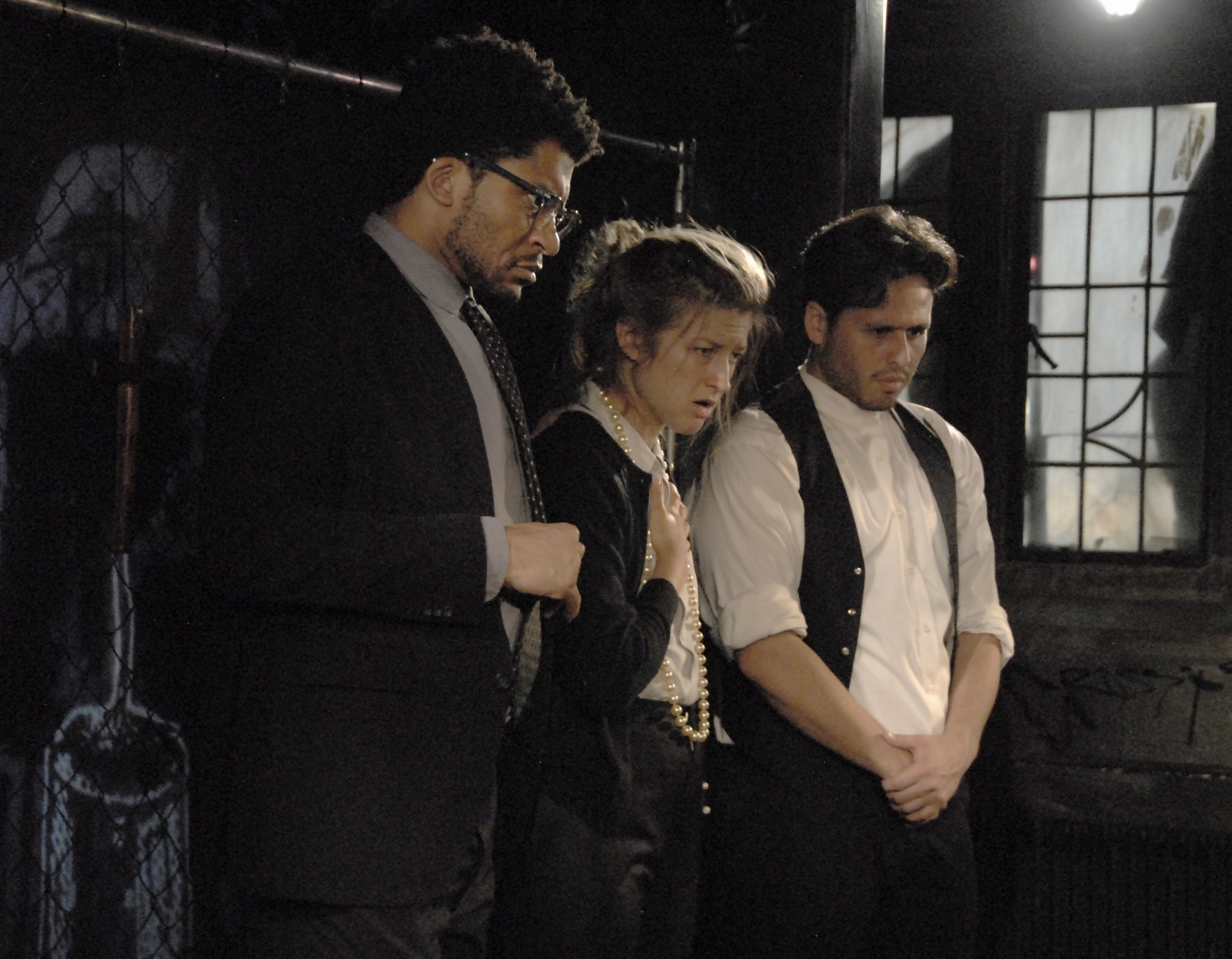Review of Antony + Cleopatra, Yale Summer Cabaret
According to historical accounts, the Battle of Actium in 31 BC was a decisive contest at sea between the fleets of Octavian Caesar, representing the interests of the Roman Republic, and those of Marc Antony and his paramour and partner in political maneuvering, Cleopatra of Egypt. In Rory Pelsue’s raucous and energetically entertaining adaptation of Shakespeare’s Antony + Cleopatra, the battle is staged as a dance routine. And that should tell you a lot about the conceptual liberties on view at the Yale Summer Cabaret through June 11.
Choreographed by Michael Breslin, the dance routine is not only theatrically appealing; in many ways it’s the culmination of the show’s drag club aesthetic, given full sway throughout the play by Cole McCarty’s genius for costumes. The dance routine is both martial and emotive, a kinetic emblem of the two sides at war, not only in the play, but in the “battle of the sexes” as an element of erotic identity. Though here the battle is in the dancers, collectively. One second, butch, the next, femme, and, we might say, the tragedy here is that the butch side keeps winning.
Octavius (Steven Lee Johnson), Cleopatra (Erron Crawford)
Pelsue’s Antony + Cleopatra seizes on the central conceit of Shakespeare’s play—that the Romans are all about organization and power and probity and the Egyptians all about their own pleasures, which power abets with a sense of grandeur—and notches it up into a series of visual arias on the status of “straight” and “gay.” In this world it’s a given that masculinity is a kind of drag performance. So the Romans, in their tennis shorts with knotted sweaters or tighty-whities or sailor and navy officer regalia or football gear, are not only “butch” but also straight-men—in the comic sense—to Cleopatra’s hand-maids, who strut and emote with a vengeance in hot pants and fish-nets and heels and bare mid-drifts. All the actors here are male—including the lovely, lithe and every inch a lady, Erron Crawford as Cleopatra. His is a performance, at one point in gold lame shorts, that maintains the elegance of both ideals of “queen”—a self-absorbed female ruler, a self-styled performance of femininity.
At the heart of the show is the question of performativity itself. Hudson Oznowicz is a very boyish Antony, as if the influence of drag-court Egypt is sapping his manliness. But then, Shakespeare’s play does put its main dramatic stress on the consul’s emotions. As a Roman, he should do what suits the Republic; as an ambitious man, he’s vying for power against Octavius; and (which interests the playwright) as a lover he is having to adapt to the whims of his fascinating and insecure femme fatale. Add Pelsue’s gendered dynamic into the mix, and this Antony is beguiled by his willingness to walk on the Wilde side, so to speak. It will be his undoing, ultimately, in a scene that shows him to be the biggest drama queen here.
Antony (Hudson Oznowicz)
Abetting such transformations in Egypt—and stealing as many scenes and masticating as much scenery as possible—are Cleo’s handmaids, Charmian (Arturo Soria), often spouting her lines in Spanish, and Iras (Jakeem Powell), the more stately of the two. They are nothing short of full-time provocations. Soria, often with a lollipop and in pigtails, also sports a moustache (that helps with his macho swagger as Agrippa, back in Rome). There’s never a dull moment with these two. And to demonstrate ancient superstition, there’s Steven Lee Johnson, in elaborate headgear, as a somewhat truculent soothsayer.
Soothsayer (Steven Lee Johnson)
Among the Romans, Johnson plays Octavius in a kind of deliberative pique. Johnson has a way with characters at least somewhat sociopathic, and his Octavius never seems so dangerous as when he is trying to seem likeable. At times, he and Antony, with their clean-cut sheen, look and act like two jocks competing to become captain of the team. As Enobarbus, Ben Anderson registers disbelief at Antony’s changed nature, while as Octavia, sister to Octavius and wife to Antony, he’s a hilariously skittish patrician dame.
Six actors play eleven named parts. With the many switches of location and costume, it can be a little tough at times to follow the intricacies of the plot, but the emotional registers come across loud and clear. Sometimes major speeches are delivered as songs, mike in hand. Actors leap atop a table, sit at tables shared by audience members, sprawl on divans, deliver orations at a mike-stand, and in general cavort with a reckless abandon that, to a heady and liberating extent, makes the Bard its bitch.
Cleopatra (Erron Crawford)
Riw Rakkulchon’s set decks the walls with gay subculture posters that seem to date from the heyday of pre-AIDS promiscuity and includes, of course, a movie poster of Liz Taylor as Cleopatra. The grand dames of Hollywood have long since become the stuff of drag, so it’s only fitting that Shakespeare’s Cleopatra gets the treatment. Crawford’s queen exudes seductive charm but she might also have a knack for wielding power that the Romans just don’t get, Antony included.
There are subtleties galore in Pelsue’s vision of the play, and several exposures might be required before one gets the full effect. “It’s a crash course for the ravers.”
Antony + Cleopatra
By William Shakespeare
Adapted and directed by Rory Pelsue
Dramaturg: Catherine María Rodríguez; Choreographer: Michael Breslin; Scenic Design: Riw Rakkulchon; Costume Design: Cole McCarty; Lighting Design: Krista Smith; Sound Design: Michael Costagliola; Stage Manager: Olivia Plath; Fight Director: Shadi Ghaheri; Spanish Translations: Arturo Soria
Cast: Ben Anderson; Erron Crawford; Hudson Oznowicz; Steven Lee Johnson; Jakeem Powell; Arturo Soria
Yale Summer Cabaret
June 2-11, 2017













